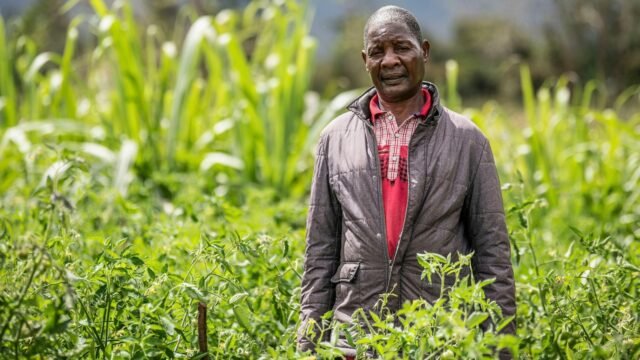Mulanje, Malawi – Alex Maere survived the devastation of Cyclone Freddy when it ripped through southern Malawi in 2023. His farm did not.
The 59-year-old saw decades of work disappear with precious soil washed away by floods from his small-scale farm at the foot of Mount Mulanje.
He was used to producing a healthy 850 kilograms (1,870 pounds) of corn each season to support his three daughters and two sons. He saved only 8 kilograms (17 pounds) from the wreckage of Freddy.
“This is no joke,” he said, recalling how his farm in Sazol village became a wasteland of sand and rock.
Freddy encouraged Maere into action. He decided he had to change his old tactics if he wanted to survive.
Now he is one of thousands of small-scale farmers in the southern African country using a generative AI chatbot developed by the non-profit organization International to receive farming advice.
The Malawian government is supporting the project, seeing as the agriculture-dependent nation has recently been hit by a series of cyclones and a drought caused by El Niño . Malawi’s food crisis, which depends largely on the struggles of small-scale farmers, is a key issue in its national elections next week.
More than 80% of Malawi’s 21 million people rely on agriculture for their livelihoods, and the country has one of the highest poverty rates in the world, according to the World Bank.
The AI chat suggested that Maere grow potatoes alongside his staple corn and cassava last year to adapt to his altered soil. He said he followed the instructions to the letter and cultivated half a football field’s worth of potatoes and earned more than $800 in sales, turning his fortunes around and those of his children.
“I managed to pay for their school fees without any worries,” he beamed.
Artificial intelligence has the potential to upend agriculture in sub-Saharan Africa , where an estimated 33-50 million smallholder farms like Maere produce up to 70-80% of the food supply, according to the UN’s International Fund for Agricultural Development. However, productivity in Africa—with the world’s rapidly growing population to feed—is lagging behind, despite vast tracts of arable land.
As AI applications surge around the world, it helps African farmers access new information to identify crop diseases, predict droughts, design fertilizers to increase yields, and even find an affordable tractor. According to the World Bank, private investment in agriculture-related technologies in sub-Saharan Africa has grown from $10 million in 2014 to $600 million in 2022.
But not without challenges.
Africa has hundreds of languages for AI tools to learn. Even then, few farmers have smartphones, and many cannot read them. Electricity and internet service are patchy at best in rural areas and often non-existent.
“One of the biggest challenges to using AI sustainably in African agriculture is accessibility,” said Daniel Mwalo, a technology specialist in Malawi. “Many tools do not take into account linguistic diversity, low literacy, and poor digital infrastructure.”
AI rīks Malāvijā mēģina to darīt. Lietotni sauc par Ulangizi, kas nozīmē padomnieku valsts Chichewa valodā. Tas ir balstīts uz WhatsApp un darbojas Chichewa un angļu valodā. Jūs varat ierakstīt vai runāt savu jautājumu, un tas atbild ar audio vai teksta atbildi, sacīja Ričards Čongo, Opportunitional International valsts direktors Malāvijā.
“Ja jūs nevarat lasīt vai rakstīt, varat nofotografēt savu ražas slimību un pajautāt:” Kas tas ir? ” Un lietotne atbildēs, ”viņš sacīja.
Bet, lai strādātu Malāvijā, AI joprojām ir vajadzīgs cilvēka pieskāriens. Maere apgabalā tas ir 33 gadus vecā Patrika Napanja, lauksaimnieku atbalsta aģenta, kurš atnes viedtālruni ar lietotni, darbs tiem, kuriem nav ierīču. Čongo viņu sauc par “cilvēku cilpā”.
“Es mēdzu cīnīties, lai sniegtu atbildes uz dažiem lauksaimniecības izaicinājumiem, tagad es izmantoju lietotni,” sacīja Napanja.
Lauksaimnieku atbalsta aģentiem, piemēram, Napanja, parasti ir aptuveni 150-200 lauksaimnieki, kas palīdz un mēģina viņus apmeklēt ciematu grupās reizi nedēļā. Bet dažreiz lielākā daļa stundu ilgas sanāksmes tiek uzņemta, gaidot reakcijas uz slodzi apgabala sliktā savienojamības dēļ, viņš sacīja. Citreiz viņiem ir jānovelk tuvumā esošie kalni, lai iegūtu signālu.
Tie ir vienkāršie, bet spītīgie šķēršļi, kas miljoniem saskaras, izmantojot tehnoloģijas priekšrocības, kas citiem ir pa rokai.
Āfrikas lauksaimniekiem, kas dzīvo uz nabadzības malas, sliktu padomu vai AI “halucinācijas” ietekme var būt daudz postošāka nekā tiem, kas to izmanto, lai organizētu savus e -pastus vai izveidotu darba prezentāciju.
Tehnoloģiju speciālists Mvalo brīdināja, ka neprecīzi AI padomi, piemēram, tērzēšanas robots, kas nepareizi identificē kultūraugu slimības, var izraisīt rīcību, kas sabojā ražu, kā arī cīnās par lauksaimnieka iztiku.
“Uzticēšanās AI ir trausla,” viņš teica. “Ja tas neizdodas pat vienu reizi, daudzi lauksaimnieki to nekad vairs nevar izmēģināt.”
Malāvijas valdība ir ieguldījusi Ulangizi, un tā ir ieprogrammēta, lai saskaņotu ar pašas lauksaimniecības ministrijas oficiālajiem lauksaimniecības konsultācijām, padarot to atbilstošāku Malāvijas iedzīvotājiem, sacīja Vebsters Jassi, Lauksaimniecības paplašināšanas metodoloģijas virsnieks ministrijā.
Bet viņš sacīja, ka Malāvija saskaras ar izaicinājumiem, lai sasniegtu rīku pietiekami daudz kopienu, lai radītu ievērojamas pārmaiņas. Šīm kopienām ir nepieciešami tikai viedtālruņi, bet arī var atļauties piekļuvi internetam.
Malāvijai potenciāls var būt AI apvienošana ar tradicionālo sadarbību starp kopienām.
“Lauksaimnieki, kuriem ir pieejama lietotne, palīdz kolēģiem lauksaimniekiem,” sacīja Jasijs, un tas uzlabo produktivitāti.
___
Plašāk par Āfriku un attīstību: https://apnews.com/hub/africa-pulse
The Associated Press receives financial support for global health and development coverage in Africa from the Gates Foundation. AP is solely responsible for all content. Find AP’s standards for working with philanthropies, a list of supporters, and funded coverage areas at Ap.org Local














